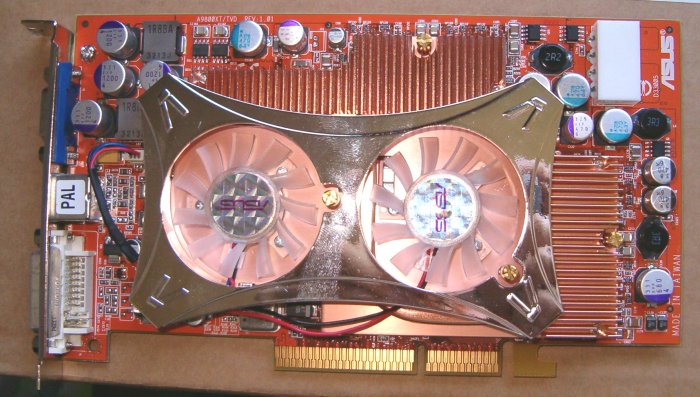ASUS Radeon 9800XT/VTD
While I pondered, and indeed initially wrote, seperate articles on both the reference board and ASUS' retail implementation, I eventually decided to combine the two for brevity. So todays real star of this article is ASUS' very first Radeon based partner board. With ASUS resolutely NVIDIA supporters ever since the original TNT, their recent inclusion of a range of products based on ATI GPU's has been the talk of the graphics card industry ever since they announced it.Being one of the higher volume AIB's in the graphics card market brings a lot of clout. ASUS supplying Radeon boards is a big thumbs up for ATI's ArtX designed products. I think I'm right in saying that nobody, except possibly MSI in some markets, sells more graphics cards to retail than ASUS.
I wont tease you with empty questions asking if it's the same as the reference board. It's ASUS, we know it's not. Here's the card in the flesh.

Copper clad, just like the reference sample, it's subjectively a little heavier. Given ASUS' GeForceFX 5900 Ultra, with its silly amounts of copper cooling both front and back of the card, it was entirely expected they'd do something similar with the 9800XT. Using a twin fan design just like the 5900's they produce, it gives the card a very distinctive look. But the front of the ASUS is a lot less interesting than the back. Here's a shot, see if you can spot why.

Copper clad, blah blah. The cool part lies in the bottom right. To save you getting eye strain, here's what I mean.

The astute among you will recognise the Rage Theater ASIC from recent All-In-Wonder products from ATI. But before you get all excited, it's not an All-In-Wonder card. The RT ASIC used on the ASUS isn't a full blown RT200 as usually used on AIW's. A pared down version, it gives the ASUS VIVO capabilities, without the multi signal processing and audio demuxing goodness of an RT200 equipped AIW.
Analogous to the various Connexant and Philips chips you'll see on VIVO'd NVIDIA boards, the RT ASIC allows capture of a video stream from a compatible video source, along with TV output display as you expect from all cards these days. There's the main difference between the ASUS and the reference board, the cooling is peripheral.
I've used up my reasonable picture size budget for this page, a fresh one is needed since there's still a lot to look at.









